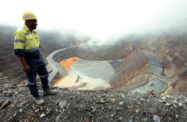Rapid economic expansion in Papua New Guinea (PNG) has produced some challenges, including the question of how to supply electricity to a growing population spread across 450,000 sq km of rugged terrain. However, the government’s long-term bid to boost both generation and distribution capacity is making progress, with plans to build new infrastructure for the sector rapidly gathering pace.
Demand growing quickly
Energy consumption is expected to increase by an average 10.5% per year up to 2030, when it will reach a projected peak load of 1400 MW. This is in part due to the government’s plan to extend power to under-served areas. PNG has targeted 70% access to electricity by 2030, up from around 13% today.
Installed capacity stands at 500 MW, a figure that the government would like to increase to 1970 MW by 2030. Alternative energy sources are earmarked for a key role in the power mix, with 1020 MW set to be obtained from hydroelectric facilities and 500 MW from other renewable sources. A total of 390 MW will be sourced from gas-fired thermal, while 60 MW will come from a combination of diesel and coal-fuelled plants.
The hydroelectric segment offers significant potential. The World Bank estimates that PNG could eventually have a generation capacity of 4200 MW from hydropower alone, setting the scene for the country to become a regional electricity exporter.
While foreign sales remain a distant possibility, PNG’s plans to generate more power for the domestic market are well on track, paving the way for significant growth across the sector. A government decision taken two years ago to begin investing heavily in PNG Power, the state-owned entity responsible for the generation and distribution of electricity, is already yielding results.
PNG is expanding the reach of its three grids, the Port Moresby, Ramu and Gazelle systems. The upgrading of existing infrastructure, together with new builds, is reducing distribution inefficiencies and loss, while also providing spare capacity. Funds for projects have been made available through the PGK160m ($64.8m) national Electricity Investment Programme.
Investments in capacity
On the generation side, the phased Yonki Project is headlining the push, led by the PGK58m ($23.5m) 75-MW Ramu 1 hydro dam rehabilitation, which should be completed this year. A second PGK55m ($22.3m) phase will complete the refurbishment of the facilities, which date back almost 40 years. Construction of the 18-MW, PGK92m ($37.2m) Yonki Toe of the Dam hydro power station, meanwhile, is also expected to be finalised this year.
The bulk of new production, however, will come from infrastructure still to be rolled out. Feasibility studies are being undertaken on nine power generation sites, including the Ramu 2 hydropower project, which would involve the construction of a new power plant in phases to reach a total installed capacity of 240 MW.
In September 2012, Ben Micah, the minister for public enterprises and state investments, told investors that the estimated cost of the Ramu 2 project was PGK2bn ($809.5m), adding that neither the state nor PNG Power had the borrowing capacity to finance such an undertaking. “Therefore, if this and other large projects are to go ahead, private sector participation will be required across the board. [The government] is seeking private sector partners for Ramu 2, for which a PGK45m ($18.2m) feasibility study is now under way,” he said.
The administration is also looking to restructure PNG Power, which has regulatory responsibilities in addition to being the primary source of power generation and distribution. While the government began actively pursuing this agenda in early 2013, the details as to how the process will move forward are still unclear. However, the establishment of a separate regulatory body is likely, as is the divestiture of at least some generation capacity.
Still, investors in the power sector could face obstacles, which have slowed growth in the past, including issues of right of way for power lines, a resistance to paying for electricity and limited road access to many areas. As John Avira, director of PNG Power’s Rural Services Division, told OBG, “The key challenges which have a major bearing on meeting the 70% electrification ratio are funding, land rights and logistics.”
However, progress remains solid, buoyed by the successful completion of Exxon-Mobil’s $19bn LNG investment and assured economic and population growth. “The project’s completion in 2014 will demonstrate that large complex developments can be successfully executed here,” Peter Graham, Esso Highland’s Managing Director told OBG.

